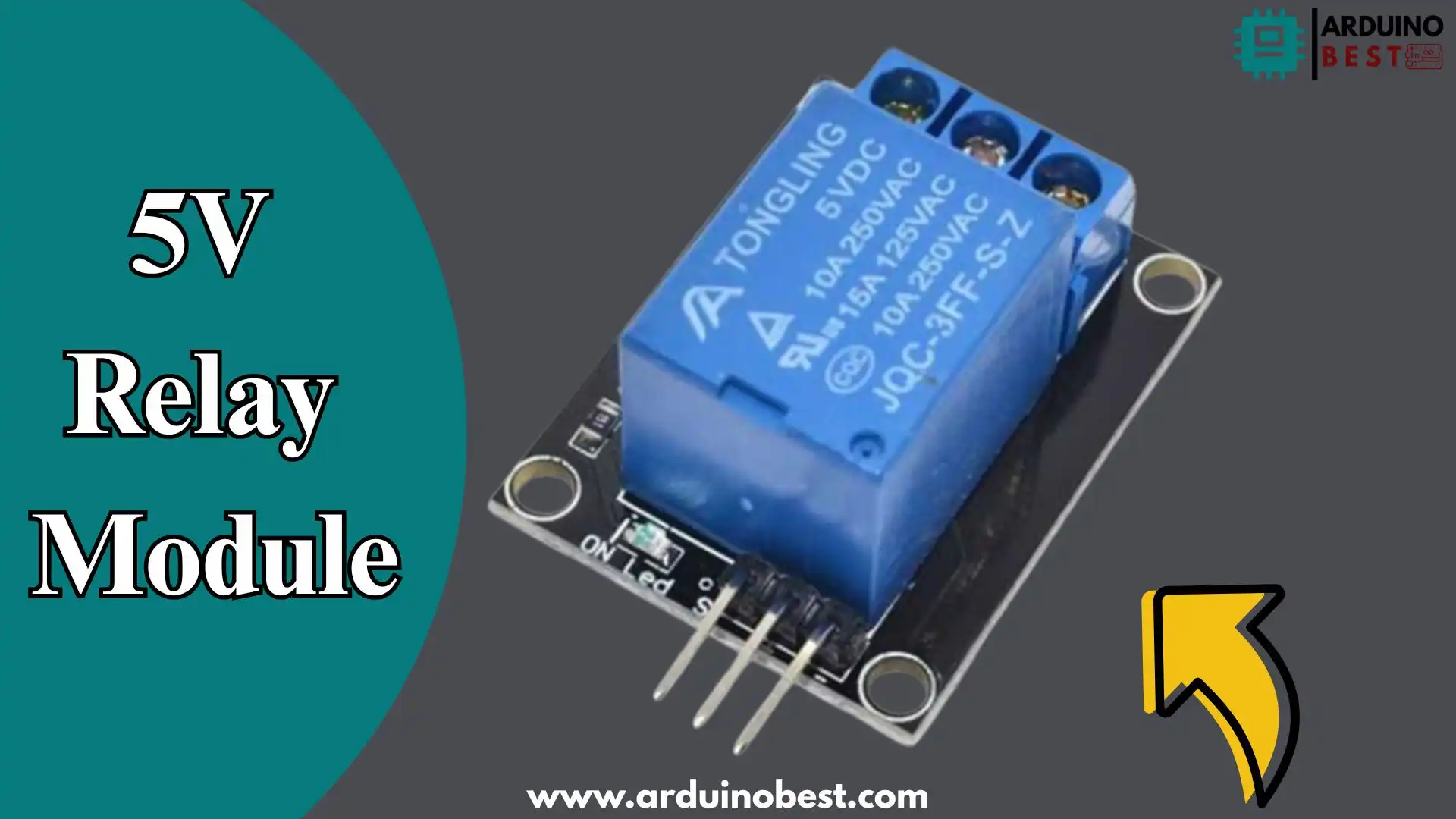Table of Contents
Introduction to 5V Relay Module
A 5V relay module is an essential component in electronics and automation, allowing you to control high-voltage devices using a low-voltage microcontroller, such as an Arduino or Raspberry Pi. Relays are electromechanical switches that can open or close circuits based on an electrical signal. By using a 5V relay module, you can effectively control devices like lights, motors, and other electrical appliances safely.
Relays are crucial when it comes to isolating sensitive electronic systems (such as microcontrollers) from high-voltage systems, providing a secure and reliable way to interact with the real world. For more detailed information on how to work with relay modules in your projects, check out this Arduino relay module tutorial.
What is a 5V Relay Module?
A 5V relay module is a small electronic component that consists of a relay switch, typically an electromechanical relay, and associated control circuitry designed to operate on a 5V power supply. These modules often come with essential features such as diode protection, optocouplers, and status LEDs to make them easy to use in a variety of applications.
Key Components of a 5V Relay Module:
- Relay: The primary switching element, typically using electromagnetic induction to open and close a switch.
- Optocoupler: Provides electrical isolation between the low-voltage control circuit and the high-voltage controlled circuit.
- Diode: Protects the module from voltage spikes caused by inductive loads (e.g., motors).
- LED Indicator: Shows the status of the relay (whether it is on or off).
Unlike other types of relay modules, 5V relay modules are widely used in Arduino projects due to their compatibility with standard 5V microcontrollers. They allow users to easily interface low-voltage control circuits with high-voltage outputs, without worrying about damage to the microcontroller. If you want to learn how to connect a relay to your Raspberry Pi, visit Raspberry Pi relay control guide.
How a 5V Relay Module Works
A 5V relay module works by using a small current to activate a larger, high-voltage device. The operation can be broken down into the following steps:
- Coil Energization: When a 5V signal is applied to the relay’s coil, it generates a magnetic field.
- Switch Activation: The magnetic field causes the relay’s contacts (switch) to move, either closing or opening the circuit.
- Contact Types: The contacts on the relay may be NO (Normally Open) or NC (Normally Closed), which defines the state of the switch when the relay is not activated.
Key Features:
- Low-Voltage Control: Microcontrollers like Arduino or Raspberry Pi use 5V digital output pins to control the relay.
- High-Voltage Switching: The relay can control high-voltage devices, up to 250V AC or 30V DC, depending on the relay’s specifications.
This system allows you to control high-power devices using a low-power signal, enabling automation of various tasks. For instance, you can control a light or fan with a small current from an Arduino.
Types of Relay Modules
There are different types of relay modules, each suited for specific tasks. Let’s explore the most common ones:
1. Single-Channel Relay Module
- Used for controlling one device.
- Great for simple automation projects where you only need to switch one appliance on or off.
2. Multi-Channel Relay Modules
- Available in 2, 4, 8, or more channels.
- Allows you to control multiple devices simultaneously from a single microcontroller.
3. Solid-State Relay (SSR)
- An electronic version of a relay that does not use mechanical parts.
- Offers faster switching times and longer lifespan compared to mechanical relays.
4. Mechanical Relay
- Uses electromagnetic coils and mechanical switches.
- Generally, cheaper but has slower switching times and is less durable than SSR.
When choosing a relay module, consider factors such as the number of channels, voltage and current ratings, and whether you need mechanical or solid-state relays.
Applications of 5V Relay Modules
5V relay modules are used in a wide variety of applications. Below are some common use cases:
1. Home Automation
- 5V relay modules are ideal for automating home appliances like lights, fans, and heaters. You can use microcontrollers like Arduino to control your devices remotely via a smartphone or a web application.
2. Security Systems
- Relays are used in alarm systems and gates to control the operation of sensors and alert systems.
- Example: Use a relay to activate a security alarm when a door is opened.
3. Industrial Automation
- In industrial settings, relay modules are used to control machines and other high-power equipment safely.
- Relays help in switching large electrical loads with smaller, low-voltage control signals.
4. Robotics
- 5V relay modules are used in robotics to control various components such as motors, lights, and other peripheral devices.
How to Use a 5V Relay Module with Arduino
Using a 5V relay module with Arduino is simple and straightforward. Here’s how you can do it:
Steps to Connect:
- Wiring the Relay: Connect the relay module to the Arduino board. The IN pin of the relay connects to one of the digital pins on the Arduino, and the VCC and GND pins go to the 5V and GND pins on the Arduino.
- Control the Relay: Write a simple program to control the relay using the digital output pin of the Arduino.
Sample Code:
cppCopyEditint relayPin = 7; // Pin connected to the relay module
void setup() {
pinMode(relayPin, OUTPUT); // Set the relay pin as an output
}
void loop() {
digitalWrite(relayPin, HIGH); // Activate the relay (turn on the device)
delay(1000); // Wait for 1 second
digitalWrite(relayPin, LOW); // Deactivate the relay (turn off the device)
delay(1000); // Wait for 1 second
}
This simple program turns a device on and off every second, demonstrating how easy it is to control a 5V relay module with Arduino.
How to Use a 5V Relay Module with Raspberry Pi
If you’re using a Raspberry Pi for your project, controlling a 5V relay module is also straightforward. Here’s a guide to help you get started:
Wiring the Relay:
- 5V relay modules are easily connected to the Raspberry Pi’s GPIO pins.
- Make sure the relay module is powered by the 5V pin of the Raspberry Pi.
Python Code Example:
pythonCopyEditimport RPi.GPIO as GPIO
import time
relayPin = 17 # Pin connected to the relay module
GPIO.setmode(GPIO.BCM)
GPIO.setup(relayPin, GPIO.OUT)
while True:
GPIO.output(relayPin, GPIO.HIGH) # Turn the relay on
time.sleep(1)
GPIO.output(relayPin, GPIO.LOW) # Turn the relay off
time.sleep(1)
This Python script allows you to turn on and off a device connected to the relay module every second using a Raspberry Pi.
Key Features to Look for in a 5V Relay Module
When selecting a 5V relay module, consider the following features to ensure compatibility with your project:
- Optocoupler: This provides electrical isolation between the low-voltage control circuit and high-voltage controlled circuit.
- Relay Type: Decide between SPDT (Single Pole Double Throw), DPDT (Double Pole Double Throw), or others depending on your switching needs.
- Diodes: Check for flyback diodes that protect the relay from voltage spikes caused by inductive loads.
- Contact Ratings: Ensure the relay can handle the voltage and current of the devices you’re controlling.
FAQs
What is a 5V relay module used for?
A 5V relay module is used to control high-voltage devices using a low-voltage signal from a microcontroller or other control systems.
How do you wire a 5V relay module to a microcontroller?
Connect the VCC and GND pins to the corresponding pins on the microcontroller and connect the IN pin to a digital output pin to control the relay.
Can a 5V relay handle high-voltage appliances?
Yes, 5V relay modules can control high-voltage appliances (e.g., 250V AC) as long as the relay’s specifications support the voltage and current ratings of the appliances.
What is the difference between a 5V relay and a 12V relay?
A 5V relay works with 5V control signals, while a 12V relay is designed to be controlled by a 12V signal. The choice depends on the voltage of your microcontroller or the system you’re using.
Can a 5V relay module be used for AC applications?
Yes, many 5V relay modules are designed to handle both AC and DC circuits, though you should always check the voltage and current ratings before use.
Arduino Projects:
1- Complete Guide for DHT11/DHT22 Humidity and Temperature Sensor With Arduino
2- DHT11 – Temperature and Humidity Sensor
3- DHT22 – Temperature and Humidity Sensor (more accurate than DHT11)
4- BMP180 – Barometric Pressure and Altitude Sensor
5- BMP280 – Barometric Pressure & Temperature Sensor
6- BME280 – Temperature, Humidity, and Pressure Sensor
7- Arduino Flex Sensor Controlled Robot Hand
8- Arduino ECG Heart Rate Monitor AD8232 Demo
9- Arduino NRF24L01 Wireless Joystick Robot Car
10- Arduino Force Sensor Anti-Theft Alarm System
11- Arduino NRF24L01 Transceiver Controlled Relay Light
12- Arduino Rotary Encoder Controlled LEDs: A Complete Guide

